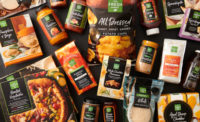Product Development: Private label steps up to the plate
Something funny is going on in grocery freezer cases across North America. Some frozen meals and entrees, it seems, have been getting a rather frosty reception from consumers.

Something funny is going on in grocery freezer cases across North America. Some frozen meals and entrees, it seems, have been getting a rather frosty reception from consumers.
Unit sales were down for many of these segments during the 52 weeks ending April 20, 2008, according to data from Information Resources Inc. (IRI), Chicago. IRI reported total category unit sales declines of 0.6 percent, 4.3 percent, 13.7 percent and 2.5 percent, respectively, for frozen breakfast food, frozen multi-serve dinners/entrees, frozen pot pies and frozen single-serve dinners/entrees (excluding Wal-Mart, club stores and convenience stores). With a 4.4 percent jump in total category unit sales, frozen handheld entrees were the sole exception to the downward trend.
What’s going on?
It could be that consumers are beginning to reach for more refrigerated prepared offerings - although the latest prepared meals category review from Mintel International, Chicago, notes that only 10 percent of global launches of chilled prepared meals between October 2007 and March 2008 were in North America. Mintel does add, however, that the North American refrigerated segment has potential for growth, “given North American interest in more natural and quality ingredients.”
Whatever the reason for the slump, processors and retailers who play close attention to consumer wants and needs will have an opportunity to win consumers back. And retailers just entering the frozen meals category couldn’t pick a better time - private label penetration is much lower than it is in many other segments, and a value proposition in line with current trends could be just the ticket to success.
Single-serve frozen dinners and entrees, in particular, have been “underserved” when it comes to private label - but this appears to be changing. In fact, IRI data reflect whopping 138.8 percent and 150 percent increases in private label dollar and unit sales, respectively, for this segment during the 52 weeks ending April 20, 2008 - proof that more retailers are getting into the private label single-serve game.
While, the frozen meals arena long has been dominated by the national brands it suddenly is becoming more of a destination for store brand innovation. Examples include Pleasanton, Calif.-based Safeway’s Eating Right and O Organics brands and Cincinnati-based Kroger’s Private Selection brand.
Michael Pritchett is vice president of sales and marketing, USA for Cordon Bleu-Tomasso Inc., South Natick, Mass., which processes both branded and private label food products.
“I think what’s happened is the same trend that happened in other private label categories maybe two or three to four years ago has finally hit the frozen entrée side of the business,” Pritchett says. “Where the standard used to be national brand equivalent, people are now expecting their [private label] frozen entrees to be better than the national brand.”
The success of some retailer’s upscale private label brands has demonstrated that quality products are well accepted by consumers, regardless of whether they are national or store brands, says Andy Horvath, senior vice president of sales for Vernon, Calif.-based Overhill Farms Inc.
“Consumers all along the income spectrum, and of every family size, are gravitating to these products,” he adds. “There is special interest in single-serving packaging, both for busy families and to suit individual family member practices.”
Private label will constitute a major growth engine in the frozen food segment, Horvath continues, in part because the current economy is forcing consumers to be more value-conscious. But the high quality of today’s store brand frozen meals “has erased the earlier perception that buying a private label product meant a tradeoff of quality for price,” he adds.
Further, the percentage of consumers choosing private label over the national brands continues to rise from year to year, says Aki Skoulakis, president of Montreal-based Skoulakis Foods Inc.
“The options for private label, I believe, are endless,” he adds. “As every year we see better-quality products being produced by better-quality manufacturers.”
Going forward, retailers can expect a significant portion of their store brand growth to come from healthier-type products, says Jeff Gehres, director of sales and product development for Request Foods, Holland, Mich. Specifically, single-serve natural and lean frozen meal items represent a growth opportunity for private label.
Skoulakis takes that advice a bit further.
“I truly believe that the area with the biggest growth opportunity in private label will be variety of flavors accompanied by nutritionally responsible manufacturing,” he says. “I think the days of 2- to 3-pound packages manufactured out of lower-quality raw products to reach a minimal price point are going the way of the dinosaur. … The manufacturers using quality raw products in a proper facility will increase their business substantially, and as their volumes go up, the price will approach the same cost to an end-user as a lower-quality manufacturer.”
Pritchett says success will hinge on the ability of manufacturers and retailers to work closely together “to develop the programs they need to be a point of difference.” He points to the success of Trader Joe’s, Whole Foods and Safeway, all of which he says have done the right things to turn their frozen programs into destination products.
Kathie Canning is editor-in-chief of PLBuyer, the magazine in which this article originally appeared in August 2008. PLBuyer is a sister magazine to Refrigerated & Frozen Foods.
Clearly, the company knows a good thing when it sees it. In the wake of this data, Fresh & Easy announced that it will launch 200 new own-brand products through the end of the year. Among these items are ready-to-eat meals: Vegetable Curry with Brown Rice, Shrimp Alfredo, Orange Chicken and Chicken Parmesan with Linguine.

Private label packaging communicates high-quality.
Something funny is going on in grocery freezer cases across North America. Some frozen meals and entrees, it seems, have been getting a rather frosty reception from consumers.
Unit sales were down for many of these segments during the 52 weeks ending April 20, 2008, according to data from Information Resources Inc. (IRI), Chicago. IRI reported total category unit sales declines of 0.6 percent, 4.3 percent, 13.7 percent and 2.5 percent, respectively, for frozen breakfast food, frozen multi-serve dinners/entrees, frozen pot pies and frozen single-serve dinners/entrees (excluding Wal-Mart, club stores and convenience stores). With a 4.4 percent jump in total category unit sales, frozen handheld entrees were the sole exception to the downward trend.
What’s going on?
It could be that consumers are beginning to reach for more refrigerated prepared offerings - although the latest prepared meals category review from Mintel International, Chicago, notes that only 10 percent of global launches of chilled prepared meals between October 2007 and March 2008 were in North America. Mintel does add, however, that the North American refrigerated segment has potential for growth, “given North American interest in more natural and quality ingredients.”
Whatever the reason for the slump, processors and retailers who play close attention to consumer wants and needs will have an opportunity to win consumers back. And retailers just entering the frozen meals category couldn’t pick a better time - private label penetration is much lower than it is in many other segments, and a value proposition in line with current trends could be just the ticket to success.
Single-serve frozen dinners and entrees, in particular, have been “underserved” when it comes to private label - but this appears to be changing. In fact, IRI data reflect whopping 138.8 percent and 150 percent increases in private label dollar and unit sales, respectively, for this segment during the 52 weeks ending April 20, 2008 - proof that more retailers are getting into the private label single-serve game.
While, the frozen meals arena long has been dominated by the national brands it suddenly is becoming more of a destination for store brand innovation. Examples include Pleasanton, Calif.-based Safeway’s Eating Right and O Organics brands and Cincinnati-based Kroger’s Private Selection brand.
Michael Pritchett is vice president of sales and marketing, USA for Cordon Bleu-Tomasso Inc., South Natick, Mass., which processes both branded and private label food products.
“I think what’s happened is the same trend that happened in other private label categories maybe two or three to four years ago has finally hit the frozen entrée side of the business,” Pritchett says. “Where the standard used to be national brand equivalent, people are now expecting their [private label] frozen entrees to be better than the national brand.”
The success of some retailer’s upscale private label brands has demonstrated that quality products are well accepted by consumers, regardless of whether they are national or store brands, says Andy Horvath, senior vice president of sales for Vernon, Calif.-based Overhill Farms Inc.
“Consumers all along the income spectrum, and of every family size, are gravitating to these products,” he adds. “There is special interest in single-serving packaging, both for busy families and to suit individual family member practices.”
Private label will constitute a major growth engine in the frozen food segment, Horvath continues, in part because the current economy is forcing consumers to be more value-conscious. But the high quality of today’s store brand frozen meals “has erased the earlier perception that buying a private label product meant a tradeoff of quality for price,” he adds.
Further, the percentage of consumers choosing private label over the national brands continues to rise from year to year, says Aki Skoulakis, president of Montreal-based Skoulakis Foods Inc.
“The options for private label, I believe, are endless,” he adds. “As every year we see better-quality products being produced by better-quality manufacturers.”
Going forward, retailers can expect a significant portion of their store brand growth to come from healthier-type products, says Jeff Gehres, director of sales and product development for Request Foods, Holland, Mich. Specifically, single-serve natural and lean frozen meal items represent a growth opportunity for private label.
Skoulakis takes that advice a bit further.
“I truly believe that the area with the biggest growth opportunity in private label will be variety of flavors accompanied by nutritionally responsible manufacturing,” he says. “I think the days of 2- to 3-pound packages manufactured out of lower-quality raw products to reach a minimal price point are going the way of the dinosaur. … The manufacturers using quality raw products in a proper facility will increase their business substantially, and as their volumes go up, the price will approach the same cost to an end-user as a lower-quality manufacturer.”
Pritchett says success will hinge on the ability of manufacturers and retailers to work closely together “to develop the programs they need to be a point of difference.” He points to the success of Trader Joe’s, Whole Foods and Safeway, all of which he says have done the right things to turn their frozen programs into destination products.
Kathie Canning is editor-in-chief of PLBuyer, the magazine in which this article originally appeared in August 2008. PLBuyer is a sister magazine to Refrigerated & Frozen Foods.
Fresh & Easy readies 200 new products
At Fresh & Easy Neighborhood Markets - U.K.-based Tesco’s stateside stores in Arizona, California and Nevada - store-brand products account for approximately 70 percent of sales. Further, 80 percent of Fresh & Easy consumers cited the company’s store brand products as their No. 1 reason for shopping at the approximately 10,000-square-foot markets.Clearly, the company knows a good thing when it sees it. In the wake of this data, Fresh & Easy announced that it will launch 200 new own-brand products through the end of the year. Among these items are ready-to-eat meals: Vegetable Curry with Brown Rice, Shrimp Alfredo, Orange Chicken and Chicken Parmesan with Linguine.
Looking for a reprint of this article?
From high-res PDFs to custom plaques, order your copy today!




